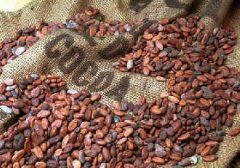Baking methods of coffee beans roasting and mixing of coffee beans

Roasting and mixing Roasting & Blending of Coffee beans
When high-quality coffee beans are picked, the most important step in making them gourmet coffee is roasting and mixing.
A master baker must have both the temperament of an artist and the rigor of a scientist. This ensures that the sugars and other carbohydrates contained in the coffee are carbonized during roasting, resulting in the well-known coffee fat and good coffee of high quality and consistent style. Academically, this subtle chemical is not really grease (because it is soluble in water), but it is the source of the aroma of coffee.
Professional coffee is generally roasted in small batches. The most common baking methods are drum baking and hot air baking.
The drum roaster puts the coffee beans in a rotating vat and burns gas or wood to bake them.
When the desired baking degree is reached, the coffee beans can be poured into a cooling funnel to prevent overbaking.
A hot air roaster, also known as a fluidization air roaster, roasts coffee beans by rolling them in hot air.
Most raw coffee beans are roasted at a temperature of nearly 400 degrees. During the baking process, the volume of coffee beans expands by more than 50%, while their weight decreases.
The color of lightly roasted coffee beans is between cinnamon and light chocolate. Because of its sour taste, it is generally not used to make espresso.
Deep baking, comparatively speaking, has a more bitter and sweet flavor. The aroma extracted from coffee beans is proportional to the baking time.
The deeper the baking, the less caffeine and acidity. The color of deep-roasted coffee beans ranges from satin chocolate to oily brown and black. The deeper the baking, the more scorched you taste, and the lighter the flavor of the coffee bean itself.
Especially deep-roasted coffee beans will have a smoky taste, which is more suitable for ordinary coffee than Italian espresso.
Many bakers use the following terms to describe different degrees of baking: cinnamon, medium baking, urban style, fully urban style, French style and Italian style.
On the west coast of the United States, "French style" is often used to describe the deepest baking. You know, this term has nothing to do with the origin of coffee or the place where it is roasted.
There are more than 100 coffee producing areas in the world, and the coffee beans produced have their own characteristics. The mixing of coffee beans is to balance the flavor of coffee in order to create an unparalleled delicacy.
A single coffee bean generally lacks the complex flavor necessary to make a delicious cup of coffee. Many blends contain three to seven different types of beans.
Roasters understand the characteristics of each kind of coffee beans and mix them artistically to create a desired new flavor. The knowledge of roasters mixing coffee beans can be said to be the highest industry secret.
In the United States, 100% Arabica coffee beans are used to mix the best blends. As mentioned earlier in the article, in Italy, some Robster beans are added to mixed coffee to increase the complexity of its fat, caffeine and coffee flavor. Italy has generations of experts who mix coffee beans.
Baking or mixing first has always been a controversial issue among bakers. Generally speaking, each product is roasted first and then mixed, which will maximize the different flavor characteristics of each kind of coffee and produce the best effect. The classic Blaser coffee beans launched by the Swiss coffee maker use this way to bring you the most delicious coffee.
Freshly roasted coffee beans release hundreds of chemicals. It takes a day or two to dissipate in order to achieve the best flavor.
Now, many high-quality roasters, such as Blaser, pack coffee beans in sealed bags with one-way valves to release the gas and prevent coffee beans from being stored in destructive gases. This kind of packing helps to maintain the good flavor of coffee beans.
If the coffee beans are not packaged in this way, when the packaging is opened, the coffee beans will begin to deteriorate. The oil on the surface of coffee beans can also go bad easily.
After the packaging of the coffee beans is opened, if preserved properly, the coffee beans will remain absolutely fresh for 10 days. We recommend that coffee beans should be kept in clean, dry, sealed containers and in a place away from light.
We do not recommend storing coffee beans in the refrigerator because they will absorb the smell from the refrigerator. Similarly, we do not recommend refrigerating coffee beans, which will also damage the quality of coffee beans, unless you want to extend the shelf life of coffee beans.
Generally take a week as a cycle, use up and buy new coffee beans, will be more ideal.
Important Notice :
前街咖啡 FrontStreet Coffee has moved to new addredd:
FrontStreet Coffee Address: 315,Donghua East Road,GuangZhou
Tel:020 38364473
- Prev

Boutique Coffee General knowledge Coffee roasting procedure
Coffee roasting is the coking of raw coffee beans at high temperature. Roasting completely changes the substances inside the raw beans to produce new compounds, which are recombined to form aroma and mellow flavor. And this effect will only happen at high temperature, if you only use low temperature, it will not cause decomposition, no matter how long the coffee beans are not cooked. Most people think that baking is nothing, just using firefighters.
- Next

Packaging of coffee beans flexible non-airtight packaging
Flexible non-airtight packaging: this is the most economical one. It is usually used by local small baking plants because they can guarantee rapid supply and coffee beans can be consumed in time. Coffee beans in this way can only be preserved for a short time. Usually no more than a week. Airtight packaging: suitable for bars, shelves or families, mainly in small bags and cans, coffee is vacuum and sealed after being packed. Due to
Related
- Beginners will see the "Coffee pull flower" guide!
- What is the difference between ice blog purified milk and ordinary milk coffee?
- Why is the Philippines the largest producer of crops in Liberia?
- For coffee extraction, should the fine powder be retained?
- How does extracted espresso fill pressed powder? How much strength does it take to press the powder?
- How to make jasmine cold extract coffee? Is the jasmine + latte good?
- Will this little toy really make the coffee taste better? How does Lily Drip affect coffee extraction?
- Will the action of slapping the filter cup also affect coffee extraction?
- What's the difference between powder-to-water ratio and powder-to-liquid ratio?
- What is the Ethiopian local species? What does it have to do with Heirloom native species?

